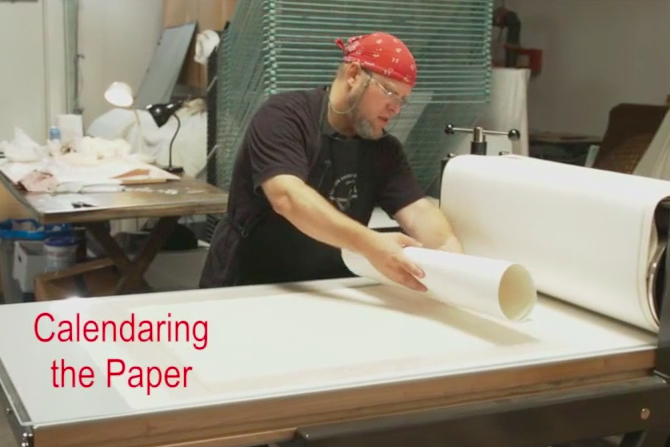
Part 5: Preparing the Paper
Watch this Video:
|
Previous Page:
|
Next Page:
|
Video Transcription Index | Watch All Printmaking Videos
More about paper calendering on our blog.
|
The following is a text transcription of Part 5 of our short, 7-part video tutorial series on photogravure intaglio printmaking using Intaglio Editions polymer photogravure plates.
Proper preparation and handling of paper is critical in creating repeatable quality with your printmaking. The choice of paper can also affect the texture, tonality, smoothness, and overall appearance of your print, so experience preparing and working with dampened paper has no substitute.
Video Transcription: Part 5 - Preparing the Paper
Demonstration of etching ink preparation
Jon Lybrook, Intaglio Editions - March 2014
"So over here we've got some fine Asian paper that's been soaking in a wet pack. I made this last night. In between pieces of blotter we've got the fine-art paper...this is a piece of kozo, which is Asian paper that is made from mulberry...and typically I will just cover this paper up, sometimes you have to blot it, but I'm just going to cover it up, I'm not actually going to put any pressure on it or try to blot it cause it feels pretty much the right consistency.
So there's a rough side and a smooth side to every paper, kozo likewise. And so what I'll do is I'll put my initials on the back of the right side that'll tell me which is the [ opposite ] printable side that we want the plate to come in contact with.
So to flatten the paper we want to put a piece of paper behind it to back it, otherwise we might get the pattern of the blankets [ embedded in the paper ], which we want to avoid.
So I'm just draining this paper. This is a heavier European paper, about 300 grams, it's about six times the weight of the Asian paper we're printing on.
We'll just pull up any particles of dust that may have gotten on the paper.
So we roll this [ larger ] paper. And so this will make the paper perfectly flat and when we print on it, it should be able to maintain the sharpness.
This is a Takach Intaglio Press and it's made in Albuquerque by the Takach Corporation, a very fine press manufacturer. You notice the drum is very wide, this is a 10-inch diameter drum. You don't want to print these plates with a drum that's smaller than this if you can avoid it. This helps to maximize the smoothness of your tones like in the sky or skin tones by putting on enough pressure. If you don't have enough pressure the tonality will kind of get broken up and you'll see noise, like white noise kind of come through the image and you'll see the paper through the ink and that's not what you want. If you're getting that, try increasing the pressure because that is generally what helps.
The important thing about running the press is not to stop. You never want to stop -- it's got to continually be in motion otherwise you might wind up with a line through your print. Speed doesn't seem to matter so much.
Now the paper should be calendared, so we will take it out...still a little bit damp. Usually I'll pick up both pieces of the paper at the same time because they'll want to stick anyway. You can see how smaooth that paper is now. There were some wrinkles kind of in it before and now they're no longer there. So I'm going to peel it off the backing sheet, because it will stick if we let it sit there long enough.
Now our kozo is just about ready to be printed on. If it gets too dry I might spritz it with some more water to recharge the fibers so it'll take the ink better, but we'll see...we'll see how that goes."
|


